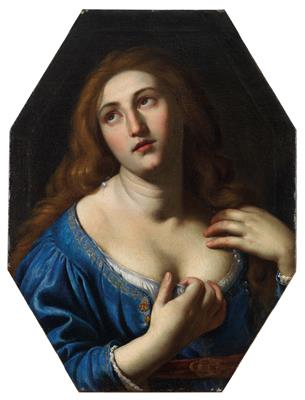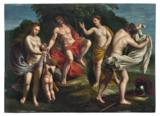Alessandro Turchi, called l’Orbetto

(Verona 1578–1649 Rome)
Mary Magdalene,
oil on canvas, octagonal, 74.5 x 56.5 cm, framed
Provenance:
possibly Collection of Charles de Créquy, Marshal of France and French Ambassador in Rome for King Louis XVIII;
possibly Collection of Cardinal Richelieu;
possibly by inheritance to his niece the Duchess de Aiguillon;
sale, Hôtel Drouot, Paris, 12 November 2015, lot 28 (as Attributed to Alessandro Turchi);
where acquired by the present owner
We are grateful to Daniela Scaglietti Kelescian for confirming the attribution on the basis of a digital photograph and for her help in cataloguing this lot. The present painting will be included in her forthcoming monograph on the artist.
This canvas represents Mary Magdalene as she breaks a string of pearls around her neck in a demonstration of her will to abandon earthly vanities in favour of aspiring to do spiritual good.
This is the only known work of octagonal format by the artist, however, the format may result from a subsequent revision of the canvas size, perhaps changed to fit the painting into a group of other works of octagonal form. On the basis of this format, Scaglietti Kelescian has, however, suggested a possible provenance for the present work. Between the seventeenth and eighteenth centuries there are records of four works by Alessandro Turchi representing Mary Magdalene in France and, among these, one appears to correspond to this characteristic format.
One of the most interesting collections in mid-seventeenth century Paris belonged to Charles de Créquy, the Marshal of France and the King’s first Gentleman of the Chamber, nominated by Louis XIII French ambassador to Rome (June 1633 to July 1634). A cultured individual interested in the arts, in a brief period he amassed a substantial collection of 160 paintings comprising of the most important artists active in Italy during the first half of the seventeenth century. According to his post mortem inventory of 1638 he owned two canvases by Alessandro Turchi, the Mystic Marriage of Saint Catherine, now in the Louvre (inv. no. 159) and a Mary Magdalene on canvas (see N. Mandarano, Dipinti di Alessandro Turchi nelle collezioni parigine negli anni Trenta e Quaranta del Seicento, in: Rome-Paris 1640, ed. by M. Bayard, Rome 2008, pp. 402-404). The latter appeared soon after in the 1643 inventory of Cardinal Richelieu, drawn up by the painters Simon Vouet and Laurent de la Hyre (‘deux piedz de hault sur un pied e demy de large’). It reappears in the collection of the cardinal’s niece, the Duchess d’Aiguillon, in 1675, in which it is specified as ‘d’un tableau octogone’ (see J. C. Boyer/I. Volf, Rome à Paris: les tableaux du maréchal de Créquy 1638, in: Revue de l’Art, no. 79, 1988, p. 27, no. XVIII). This may be the present painting.
It has been suggested that this painting dates to circa 1625 and that it was a pendant to a Saint Catherine of Alexandria by Simon Vouet (sale, Sotheby’s, 25 January 2017, lot 39; 74 x 58. 5 cm) also of octagonal format and of similar size. However, if this were the case, the Vouet would have been painted later, providing the model for the possible re-sizing of this canvas by Turchi.
The beautiful model used by Turchi in this composition, concentrated on her mystic conversion, can be compared to other saints and heroines rendered with similar features, painted by the artist from the early 1630s onward, such as the Ecstasy of Saint Mary Magdalene formerly Finarte, Milan, lot 188 and the Suicide of Cleopatra, Dorotheum, Vienna, 22 October 2019, lot 187. Also apparent in the present work is the artist’s inspiration derived from ancient roman sculpture, which as a youth he must have known and studied in Rome, and here, most notably the figure of Niobe protecting her youngest daughter, part of the Medici Niobe Group, now in the Uffizi, Florence from which he almost literally took the features and positioning of the hands for this solemn saint in the act of breaking the string of pearls.
When the painting recently appeared on the Paris art market in 2015 as attributed to Alessandro Turchi, the bust of the Magdalene was covered by a swath of mantle which has since been removed during restoration. It is likely that this drape had been added during the nineteenth century in moralistic censure.
Expert: Mark MacDonnell
 Mark MacDonnell
Mark MacDonnell
+43 1 515 60 403
oldmasters@dorotheum.com
09.06.2020 - 16:00
- Dosažená cena: **
-
EUR 10.000,-
- Odhadní cena:
-
EUR 12.000,- do EUR 15.000,-
Alessandro Turchi, called l’Orbetto
(Verona 1578–1649 Rome)
Mary Magdalene,
oil on canvas, octagonal, 74.5 x 56.5 cm, framed
Provenance:
possibly Collection of Charles de Créquy, Marshal of France and French Ambassador in Rome for King Louis XVIII;
possibly Collection of Cardinal Richelieu;
possibly by inheritance to his niece the Duchess de Aiguillon;
sale, Hôtel Drouot, Paris, 12 November 2015, lot 28 (as Attributed to Alessandro Turchi);
where acquired by the present owner
We are grateful to Daniela Scaglietti Kelescian for confirming the attribution on the basis of a digital photograph and for her help in cataloguing this lot. The present painting will be included in her forthcoming monograph on the artist.
This canvas represents Mary Magdalene as she breaks a string of pearls around her neck in a demonstration of her will to abandon earthly vanities in favour of aspiring to do spiritual good.
This is the only known work of octagonal format by the artist, however, the format may result from a subsequent revision of the canvas size, perhaps changed to fit the painting into a group of other works of octagonal form. On the basis of this format, Scaglietti Kelescian has, however, suggested a possible provenance for the present work. Between the seventeenth and eighteenth centuries there are records of four works by Alessandro Turchi representing Mary Magdalene in France and, among these, one appears to correspond to this characteristic format.
One of the most interesting collections in mid-seventeenth century Paris belonged to Charles de Créquy, the Marshal of France and the King’s first Gentleman of the Chamber, nominated by Louis XIII French ambassador to Rome (June 1633 to July 1634). A cultured individual interested in the arts, in a brief period he amassed a substantial collection of 160 paintings comprising of the most important artists active in Italy during the first half of the seventeenth century. According to his post mortem inventory of 1638 he owned two canvases by Alessandro Turchi, the Mystic Marriage of Saint Catherine, now in the Louvre (inv. no. 159) and a Mary Magdalene on canvas (see N. Mandarano, Dipinti di Alessandro Turchi nelle collezioni parigine negli anni Trenta e Quaranta del Seicento, in: Rome-Paris 1640, ed. by M. Bayard, Rome 2008, pp. 402-404). The latter appeared soon after in the 1643 inventory of Cardinal Richelieu, drawn up by the painters Simon Vouet and Laurent de la Hyre (‘deux piedz de hault sur un pied e demy de large’). It reappears in the collection of the cardinal’s niece, the Duchess d’Aiguillon, in 1675, in which it is specified as ‘d’un tableau octogone’ (see J. C. Boyer/I. Volf, Rome à Paris: les tableaux du maréchal de Créquy 1638, in: Revue de l’Art, no. 79, 1988, p. 27, no. XVIII). This may be the present painting.
It has been suggested that this painting dates to circa 1625 and that it was a pendant to a Saint Catherine of Alexandria by Simon Vouet (sale, Sotheby’s, 25 January 2017, lot 39; 74 x 58. 5 cm) also of octagonal format and of similar size. However, if this were the case, the Vouet would have been painted later, providing the model for the possible re-sizing of this canvas by Turchi.
The beautiful model used by Turchi in this composition, concentrated on her mystic conversion, can be compared to other saints and heroines rendered with similar features, painted by the artist from the early 1630s onward, such as the Ecstasy of Saint Mary Magdalene formerly Finarte, Milan, lot 188 and the Suicide of Cleopatra, Dorotheum, Vienna, 22 October 2019, lot 187. Also apparent in the present work is the artist’s inspiration derived from ancient roman sculpture, which as a youth he must have known and studied in Rome, and here, most notably the figure of Niobe protecting her youngest daughter, part of the Medici Niobe Group, now in the Uffizi, Florence from which he almost literally took the features and positioning of the hands for this solemn saint in the act of breaking the string of pearls.
When the painting recently appeared on the Paris art market in 2015 as attributed to Alessandro Turchi, the bust of the Magdalene was covered by a swath of mantle which has since been removed during restoration. It is likely that this drape had been added during the nineteenth century in moralistic censure.
Expert: Mark MacDonnell
 Mark MacDonnell
Mark MacDonnell
+43 1 515 60 403
oldmasters@dorotheum.com
|
Horká linka kupujících
Po-Pá: 10.00 - 17.00
old.masters@dorotheum.at +43 1 515 60 403 |
| Aukce: | Obrazy starých mistrů |
| Typ aukce: | Salónní aukce |
| Datum: | 09.06.2020 - 16:00 |
| Místo konání aukce: | Wien | Palais Dorotheum |
| Prohlídka: | 02.06. - 09.06.2020 |
** Kupní cena vč. poplatku kupujícího a DPH
Není již možné podávat příkazy ke koupi přes internet. Aukce se právě připravuje resp. byla již uskutečněna.
Další objekty umělce
-

Alessandro Turchi, called l’Orbetto
Odhadní cena:
EUR 20.000,- do EUR 30.000,-
Všechny objekty umělce
